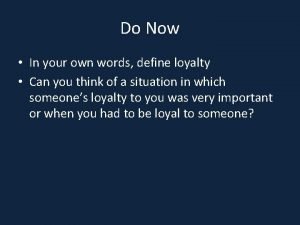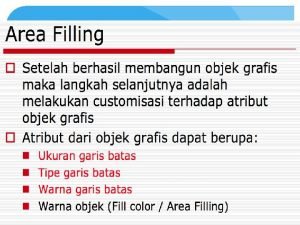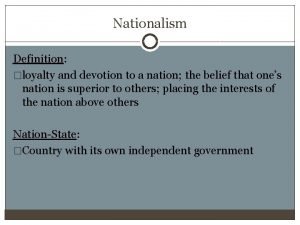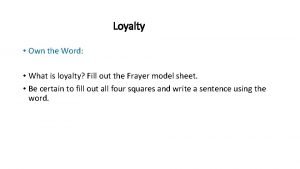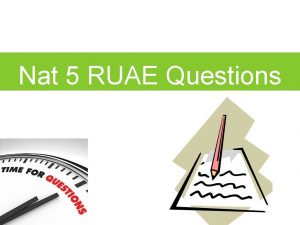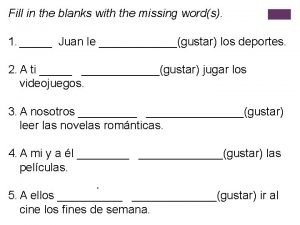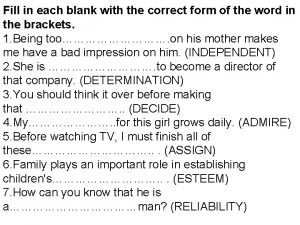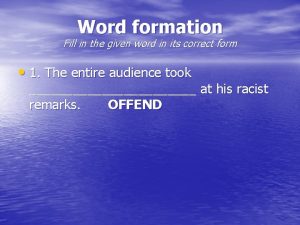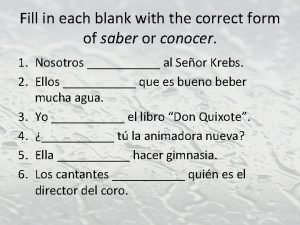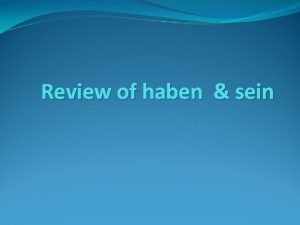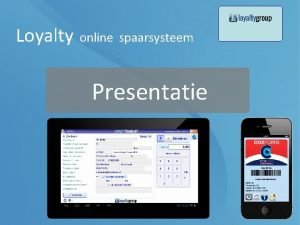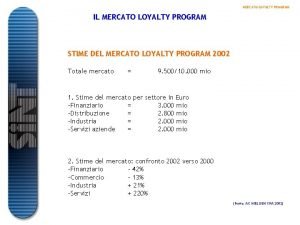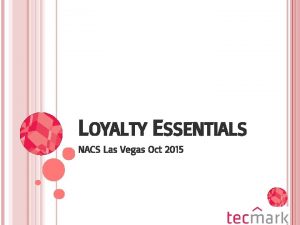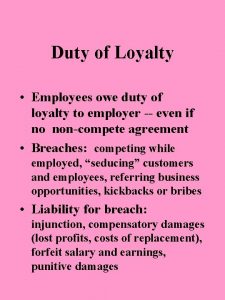Loyalty Own the Word What is loyalty Fill




















- Slides: 20

Loyalty • Own the Word: • What is loyalty? Fill out the Frayer model sheet. • Be certain to fill out all four squares and write a sentence using the word.

What is Your Ultimate Loyalty? Standard: “idea” section • Rank the following from most loyalty (1) to least loyalty (4). Use your definition of loyalty to determine the rankings. • Family • Friends • Yourself • Country • Within a small group (3 -4) discuss your rankings and your reasoning. In other words, you must defend how you ranked the four areas. • Next, students will write their definition of loyalty on butcher block paper. • Finally, students will walk around the room again and comment on at least two (2) other student definitions. • Note: Only 2 nd hour will use butcher block paper. The activity will be modified for other classes as follows: Stand up and find at least two other students to share your definition with.

Closure Activity • Was everyone able to defend their rankings? • Did everyone have the same definition of loyalty? • Is there a right or wrong answer, or is it just a matter of opinion? • Think of a controversial topic confronting us today such as partial birth abortion, recreational marijuana, etc. • Is it acceptable for people to have opposing viewpoints? • How are your views changed or challenged when you listen to another point of view? • How did this activity help you understand the standard?

Classical Greek Drama Standards: “I can” analyze how complex characters, events, and ideas develop and interact over the course of a text to impact meaning. “ “ I can” apply knowledge of language to understand how language functions in different contexts, to make effective choices for meaning or style, and to comprehend more fully when reading or listening.

Classical Drama , p. 1064 • Religious Origins: Dionysus • Theater: How is the Greek theater different from today’s theater? • Actors and Chorus • Tragedy and the tragic hero: downfall of a dignified, superior character who offends the gods • Myths and legends • Greek Deities: PP slides

Common Core Standards • RL 1: Cite strong textual evidence to support analysis of what the text says explicitly as well as inferences drawn from the text. • RL 2: Determine a theme or central idea of a text. • RL 3: Analyze how complex characters with conflicting motivations develop, interact with others, and advance the plot or develop theme. • RL 10: Read and comprehend dramas. • TERM: dramatic irony HANDOUT: Tragic Hero as defined by Aristotle A creative final project is part of this unit of study. Examples will be discussed shortly. An argumentative essay focusing on the tragic hero is part of this unit of study. An assessment (test) will occur at the end of this unit of study.

The Myth of Oedipus

The son of Laius and Jocasta, King and Queen of Thebes, Oedipus is the unfortunate main protagonist of “one of the best-known of all legends” in Ancient Greek mythology. Left, while still a baby, to die in the mountains by his father – who had been warned that his son would kill him and marry his wife – Oedipus was eventually adopted by the childless King Polybus and Queen Merope of Corinth. After accidentally finding about the gruesome prophecy himself, in fear and disgust the young Oedipus fled Corinth and – guided by cruel destiny – wound up crossing paths with his real father at a narrow crossroad; after a brief argument with Laius’ charioteer over who had the right to go first, Oedipus killed both of them. Wandering aimlessly, he subsequently reached the city of Thebes where he encountered the monstrous gateguarding Sphinx; after he answered her riddle, the Sphinx went mad and hurled herself to her death.

The Myth continued • As a reward for rescuing the city from this vicious beast, Oedipus was afterward offered the vacant throne of Thebes and the hand in marriage of the ex-king’s widow, his very own mother. Jocasta bore her son four children – Polynices, Eteocles, Antigone, and Ismene – before a belated investigation into the death of Laius led Oedipus into discovering the dreadful truth of his marriage. Upon realization, Jocasta hanged herself, and Oedipus gouged his eyes with two pins snatched from her regal dress.

Theatre in the Round

“Antigone, ” a Greek tragedy by Sophocles A family torn by dissension • • • • The Players (each will receive a printed copy of the play) Antigone Ismene Creon Haemon Eurydice Teiresias Chorus (4 students) the elders of Thebes Choragus A Sentry A Messenger Narrator Handouts: Family Tree, Tragic Hero, Student Questions, Project ideas Once a week we will discuss, as a group, questions and standards related to the play.

Reading Strategies • Visualize the staging of the play, with its masked actors. • Clarify unfamiliar references. • Infer the traits, values, and motivations of the two main characters. • Relate the songs of the chorus to the action of the play.

Prologue, Parodos and Scene 1 September 23 • Prologue: introductory section of literary work. 1. Summarize the conversation between Antigone and Ismene in 5 -8 sentences. Support your summary with textual evidence. “. . . . ” (14 -27). 2. Review lines 147 -160 of Creon’s speech. Is his reasoning sound? Support your answer with textual evidence. September 24 1. Notice how the sentry, a minor character, relates to Creon. What does Creon’s response reveal about his character? Pay particular attention to lines 229 -261. Cite textual evidence AND explain your quote.

How to make a Greek Mask • https: //www. youtube. com/watch? v=_yl 5 qm-UFks

Writing Prompt • What seems to be Creon’s fatal flaw? What seems to be his virtue? • Virtue: behavior showing high moral standards. • Refer to the handout “Tragic Hero” for traits of a tragic hero. • Remember to show evidence (5 -7). Do not use the word ‘line’ and explain the evidence.

BELL WORK 1. Construct the family tree of Oedipus from memory. 2. What is a time when you felt you had to take a stand against an injustice? 3. Where does Antigone’s loyalty lie? Creon’s 4. Evaluate the rhetorical appeals utilized in the play to determine where characters’ loyalty is placed. (9 -10. RL. KID. 1 -3, 9 -10. SL. CC. 3)

Scene IV and Ode IV Line 657 Understanding Antigone’s final speech 1. Does Antigone see herself as responsible for her death or does she feel it is a result of outside forces? 2. What rhetorical devices (ethos, pathos, logos) does Antigone use in her speech? 3. What is the connection between the three myths in Ode 4 and Antigone’s situation? In other words, how are they similar?

Friday Shared Inquiry Discussion Day • Every Friday, students are required to bring two (2) written or typed questions to class on sections of the play we have read so far. There will be a discussion grade for completing this assignment.

Scene V Each group will be given a question to discuss. Textual evidence is required for each question and each member of the group must be engaged. • What omens does Teiresias refer to (name at least two) and how do they foreshadow Creon’s future? • How does Creon respond to Teiresias’s warning? Focus particularly on Creon’s tone. • What rhetorical device(s) does Teiresias utilize in speaking to Creon? • What event results in Creon’s change of heart? What does he decide to do? • Author’s Purpose: Why does Sophocles decide not to spare Creon’s family, even when Creon decides to free Antigone and bury Polyneices? • What is the central theme of Antigone and how does it develop over the course of the play?

October Lesson Plans Note: Each group will need colored pencils on Tuesday. Please bring if you have some. Week of October 14: • 10/14: Collaboration groups: final discussion of “Antigone. ” • 10/15 -10/16: Review argumentative writing in collaboration groups. Handout: rubrics for presentations • 10/17: Write rough draft in class. Note: Class is 20 minutes today. Graphic organizers and sample outlines will be available. Complete one of these. Students presenting a completed graphic organizer 10/17 will have 5 points added to their final essay score. • 10/18: Project presentations begin Week of October 21: • 10/21 & 10/22: Project presentations continue • 10/23, 10/24, 10/25: Type essay in computer lab
 Define loyalty in your own words
Define loyalty in your own words Perbedaan boundary fill dan flood fill
Perbedaan boundary fill dan flood fill Area filling
Area filling What type of sae is when you own your own business
What type of sae is when you own your own business Boundary fill 4(x-1,y, fillcolor,________)
Boundary fill 4(x-1,y, fillcolor,________) Refers to the loyalty and devotion to a nation
Refers to the loyalty and devotion to a nation Loyalty spaarsysteem
Loyalty spaarsysteem How to answer in your own words questions
How to answer in your own words questions Write the missing words.
Write the missing words. Fill in each
Fill in each Narrate the tale of melon city in your own word
Narrate the tale of melon city in your own word Word formation fill in the correct form
Word formation fill in the correct form Fill in each blank with the correct time.
Fill in each blank with the correct time. Fill in the correct word
Fill in the correct word Fill in each blank with a suitable word
Fill in each blank with a suitable word Hình ảnh bộ gõ cơ thể búng tay
Hình ảnh bộ gõ cơ thể búng tay Frameset trong html5
Frameset trong html5 Bổ thể
Bổ thể Tỉ lệ cơ thể trẻ em
Tỉ lệ cơ thể trẻ em Gấu đi như thế nào
Gấu đi như thế nào Tư thế worm breton là gì
Tư thế worm breton là gì
